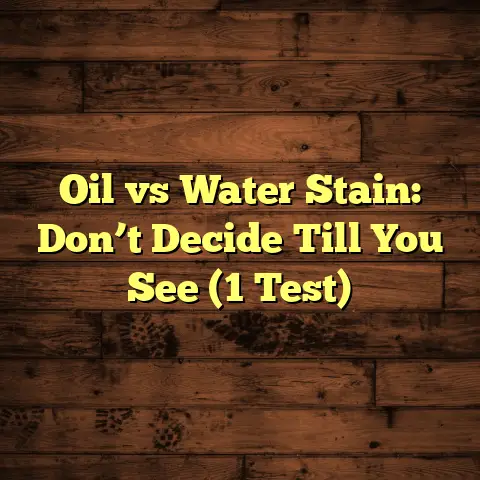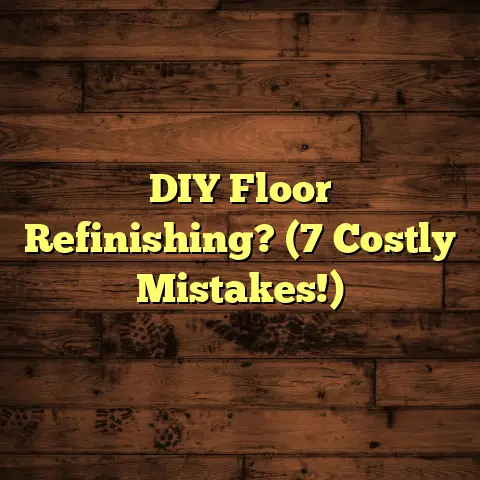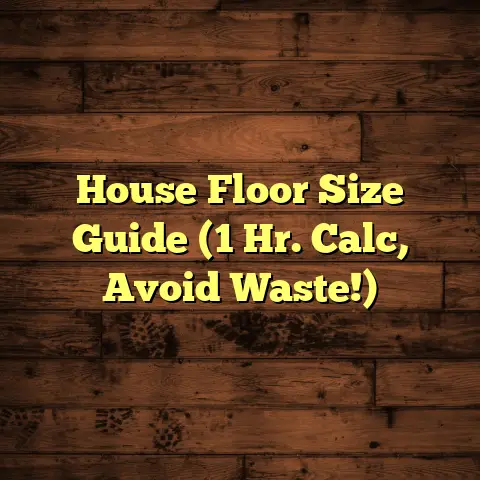Laminate In Garage? (8 Moisture Risks Exposed!)
Home improvement, isn’t it a never-ending journey?
It feels like just yesterday I was helping a client
pick out the perfect backsplash, and now we’re
talking about flooring for the garage?
Times change,
and so do our ideas about what a garage can be.
Laminate flooring, once relegated to kitchens and
living rooms, is popping up in some unexpected places.
I’ve seen it in basements, home offices, and yes,
even garages.
But hold on a second!
Before you
start ripping up that concrete, let’s talk about
the potential pitfalls of putting laminate in a space
that’s practically begging for moisture problems.
This isn’t just about aesthetics; it’s about the
long-term health of your garage and your investment.
Moisture is the enemy of laminate, and garages,
well, they’re practically moisture magnets.
I’m
talking about warping, swelling, mold, and a whole
lot of headaches.
So, let’s dive deep into those
moisture risks and how they can turn your garage
flooring dream into a soggy nightmare.
Section 1: Understanding Laminate Flooring
So, what exactly is laminate flooring?
Think of it as a multi-layered sandwich.
You’ve got a high-density fiberboard (HDF) core,
a decorative layer that mimics wood or tile, and a
tough, transparent wear layer on top.
The big selling point?
It looks like the real deal
without the hefty price tag.
Plus, it’s relatively
easy to install, which is why so many DIYers love it.
I’ve laid down miles of the stuff over the years.
One of the main reasons for laminate’s popularity is
its cost-effectiveness and durability.
It’s designed
to withstand everyday wear and tear.
For instance,
according to a report by Statista, the laminate
flooring market is projected to reach $40 billion
globally by 2027, indicating its widespread adoption.
But here’s the catch: that HDF core is basically a
sponge when it comes to water.
And while the wear
layer can handle some spills, it’s not a waterproof
shield.
That’s why understanding the material’s
properties is crucial, especially when you’re
considering putting it in a potentially damp environment.
Now, you might be thinking, “But I’ve seen laminate
in basements!
What’s the difference?” Well, basements
can be controlled environments.
Garages?
Not so much.
That leads us to the next section.
Section 2: The Garage Environment
Garages are the chameleons of the home.
One day they’re housing your car, the next
they’re a workshop, a storage unit, or even a
makeshift gym.
But one thing they almost always
have in common is their exposure to the elements.
Think about it: you’re driving in with a car covered
in snow or rain.
You’re storing lawn equipment caked
in mud.
You’re washing your car and letting the water
drain onto the floor.
All that moisture adds up.
And it’s not just the obvious stuff.
Garages often
experience wild temperature swings.
In the summer,
they can become ovens, and in the winter, they can
drop below freezing.
These fluctuations can create
condensation, which is basically invisible moisture
that can wreak havoc on your laminate.
Construction also plays a huge role.
Many garages are built on concrete slabs with minimal
insulation.
This means they’re directly exposed to
ground moisture and temperature changes.
According
to the EPA, concrete can wick moisture from the ground,
leading to indoor humidity issues.
I’ve seen garages where the humidity levels are off
the charts, even when the weather outside seems dry.
And let’s be honest, garages are often the forgotten
stepchild when it comes to home design.
People focus
on the interior of their homes and overlook the
environmental challenges their garages face.
This
often leads to flooring choices that simply aren’t
up to the task.
So, before you even think about installing laminate
in your garage, you need to understand the unique
challenges this space presents.
Because trust me,
ignoring them will cost you in the long run.
Section 3: Moisture Risk #1 – Ground Moisture
Let’s start with the silent killer: ground moisture.
Your garage floor, unless properly sealed, is like
a giant sponge sitting directly on the earth.
Moisture from the soil can wick its way up through
the concrete through a process called capillary action.
I’ve seen it time and time again.
Homeowners install
laminate directly on the concrete, thinking they’re
good to go.
A few months later, they’re dealing with
warped, buckled flooring.
Why?
Because the moisture
from the ground is slowly but surely seeping into
the laminate core.
This is especially common in older homes where the
concrete slab may not have a moisture barrier underneath.
Even in newer homes, if the vapor barrier is damaged
or improperly installed, you’re still at risk.
The American Society of Civil Engineers (ASCE)
recommends conducting a moisture test on concrete
slabs before installing any flooring to determine
the level of moisture vapor emission.
So, how does this manifest?
You might notice a musty
smell in your garage.
You might see discoloration
or staining on the underside of the laminate.
And eventually, you’ll start to see the edges lifting
and the boards warping.
The consequences can be significant.
Not only will
you have to replace the flooring, but you could also
be dealing with mold and mildew growth, which can
pose serious health risks.
How to mitigate the risk:
-
Moisture Test: Conduct a calcium chloride moisture test to determine the moisture vapor emission rate of the concrete.
-
Sealer: Apply a high-quality concrete sealer designed to block moisture.
- Underlayment: Use a moisture-resistant underlayment specifically designed for concrete slabs.
Section 4: Moisture Risk #2 – Humidity
Humidity, that invisible menace that makes your hair
frizzy and your skin sticky.
In a garage, it’s more
than just an annoyance; it’s a threat to your laminate.
High humidity levels can cause the HDF core of the
laminate to absorb moisture from the air.
This leads
to swelling, warping, and ultimately, a ruined floor.
I’ve seen entire floors buckle and lift because of
excessive humidity.
The severity of the risk depends on your geographic
location and the time of year.
If you live in a humid
climate like the Southeast, you’re at a higher risk
than someone in a dry climate like the Southwest.
And even in drier climates, seasonal changes can bring
periods of high humidity.
Garages are particularly susceptible to humidity
problems because they’re often poorly ventilated.
Think about it: you close the garage door to keep
out the weather, but that also traps moisture inside.
According to a study by the University of Minnesota,
poor ventilation can significantly increase indoor
humidity levels, leading to mold growth and structural damage.
I remember one client who insisted on installing
laminate in his Florida garage.
Despite my warnings,
he went ahead with it.
Within a year, the floor was
a disaster.
The humidity had caused the boards to
swell and buckle, and the entire floor had to be replaced.
How to mitigate the risk:
-
Ventilation: Install a ventilation system in your garage to improve airflow.
-
Dehumidifier: Use a dehumidifier to control humidity levels, especially during humid months.
- AC: If possible, extend your home’s air conditioning into the garage.
Section 5: Moisture Risk #3 – Water Spills and
Accidental Leaks
Let’s face it, garages are messy places.
You’re
constantly tracking in dirt, mud, and who knows
what else.
And when it comes to water, spills and
leaks are practically inevitable.
Whether it’s from a leaky car, a spilled bucket of
wash water, or a rogue sprinkler, water spills are
a common occurrence in garages.
And while laminate
is somewhat water-resistant, it’s not waterproof.
Prolonged exposure to water can seep through the
seams and damage the core.
I’ve seen countless cases where a small, unnoticed
spill has led to significant damage.
For example,
a client had a small leak in his car’s radiator.
Over time, the coolant dripped onto the laminate
floor, causing the boards to swell and discolor.
By the time he noticed the problem, the damage was
extensive.
And it’s not just spills you have to worry about.
Accidental leaks from plumbing fixtures, like water
heaters or washing machines, can also cause serious
problems.
If you have any plumbing in your garage,
you’re automatically at a higher risk.
How to mitigate the risk:
- Clean Up: Clean up spills immediately to prevent water from seeping into the seams.
- Waterproof Mats: Use waterproof mats under vehicles and around potential leak sources.
- Plumbing Checks: Regularly inspect plumbing fixtures for leaks.
Section 6: Moisture Risk #4 – Temperature Changes
Garages are notorious for temperature fluctuations.
They can be scorching hot in the summer and freezing
cold in the winter.
These extreme temperature changes
can wreak havoc on laminate flooring.
When temperatures rise, the laminate expands.
When temperatures drop, it contracts.
This constant
expansion and contraction can put stress on the
seams, causing them to separate or crack.
I’ve seen
floors where the edges have curled up like potato chips
due to thermal expansion.
Condensation is another major concern.
When warm,
moist air comes into contact with a cold surface,
like a concrete floor, it condenses into water.
This condensation can seep into the laminate and
cause damage.
I remember a client who lived in a cold climate.
He installed laminate in his unheated garage.
During
the winter, the temperature would drop below freezing.
When the weather warmed up, condensation would form
on the floor, leading to swelling and warping.
How to mitigate the risk:
- Climate Control: If possible, heat or cool your garage to minimize temperature fluctuations.
- Expansion Gaps: Leave adequate expansion gaps around the perimeter of the room during installation.
- Insulation: Insulate your garage to help regulate temperature and reduce condensation.
Section 7: Moisture Risk #5 – Poor Installation Practices
Even if you take all the necessary precautions, poor
installation can still lead to moisture-related problems.
Proper installation is crucial for the longevity of
your laminate floor, especially in a garage.
One of the biggest mistakes I see is inadequate
underlayment.
Underlayment provides a barrier between
the concrete and the laminate, protecting it from
moisture.
If you skip this step or use the wrong
type of underlayment, you’re asking for trouble.
Another common mistake is failing to leave adequate
expansion gaps around the perimeter of the room.
As mentioned earlier, laminate expands and contracts
with temperature changes.
If you don’t leave enough
room for expansion, the floor can buckle and warp.
I’ve also seen cases where installers have used the
wrong type of adhesive or failed to properly seal
the seams.
These mistakes can create pathways for
moisture to penetrate the laminate.
I once had to redo an entire garage floor because
the original installer didn’t use a moisture barrier.
The moisture from the concrete had seeped into the
laminate, causing it to swell and crumble.
It was
a costly mistake that could have been avoided with
proper installation.
How to mitigate the risk:
- Hire a Pro: Hire a qualified installer who has experience installing laminate in garages.
- Follow Instructions: Carefully follow the manufacturer’s installation instructions.
- Moisture Barrier: Use a moisture barrier to protect the laminate from ground moisture.
Section 8: Moisture Risk #6 – Inadequate Sealing and
Maintenance
Laminate flooring, while durable, isn’t a “set it and
forget it” kind of deal, especially in a garage.
Proper sealing and regular maintenance are essential
for preventing moisture damage and extending the life
of your floor.
Many people assume that the wear layer on laminate
is enough to protect it from moisture.
However,
the seams between the boards are vulnerable to water
penetration.
Sealing these seams can help prevent
moisture from seeping into the core.
Regular cleaning is also important.
Dirt and grime
can trap moisture and create a breeding ground for
mold and mildew.
Use a damp mop and a mild detergent
to clean your floor regularly.
Avoid using excessive
water, as this can damage the laminate.
I’ve seen cases where homeowners have neglected their
laminate floors and ended up with serious problems.
One client never cleaned his garage floor.
Over time,
dirt and grime accumulated in the seams, trapping
moisture and causing the edges to swell.
How to mitigate the risk:
- Seam Sealer: Apply a seam sealer to protect the seams from moisture.
- Regular Cleaning: Clean your floor regularly with a damp mop and a mild detergent.
- Avoid Excess Water: Avoid using excessive water when cleaning your floor.
Section 9: Moisture Risk #7 – Proximity to Plumbing
Having plumbing in your garage adds another layer of
risk when it comes to moisture and laminate flooring.
Water heaters, washing machines, and utility sinks
are all potential sources of leaks and spills.
If you have any of these fixtures in your garage,
you need to be extra vigilant about checking for
leaks.
Even a small, slow leak can cause significant
damage over time.
I remember a client who had a water heater in his
garage.
One day, the water heater started leaking.
The leak went unnoticed for several days, and the
water seeped under the laminate flooring.
By the
time he discovered the problem, the floor was completely
ruined.
How to mitigate the risk:
- Regular Inspections: Regularly inspect plumbing fixtures for leaks.
- Water Detection: Install a water detection system to alert you to leaks.
- Waterproof Mats: Use waterproof mats under plumbing fixtures to catch spills.
Section 10: Moisture Risk #8 – Lack of Airflow
Finally, let’s talk about airflow.
Proper ventilation
is crucial for preventing moisture buildup in your
garage.
Without adequate airflow, humidity can become
trapped, creating a breeding ground for mold and
mildew.
Garages are often poorly ventilated.
They’re typically
closed off from the rest of the house and lack windows
or vents.
This can lead to high humidity levels,
especially during humid months.
I’ve seen garages where the air is thick and stagnant.
You can practically feel the moisture in the air.
This is a recipe for disaster when it comes to
laminate flooring.
I had a client who had a garage that was completely
sealed off.
He installed laminate flooring, but within
a few months, the floor started to buckle and warp.
The lack of airflow had trapped moisture in the garage,
causing the laminate to deteriorate.
How to mitigate the risk:
- Ventilation: Install a ventilation system in your garage to improve airflow.
- Open Windows: Open windows and doors whenever possible to allow fresh air to circulate.
- Exhaust Fan: Install an exhaust fan to remove moisture from the garage.
Conclusion
So, there you have it: eight moisture risks that you
need to consider before installing laminate flooring
in your garage.
As I’ve shown you, moisture is the
number one enemy of laminate, and garages are often
moisture-prone environments.
Understanding these risks is crucial for making
informed decisions about flooring materials.
While
laminate can be a cost-effective and attractive
option, it’s not always the best choice for garages.
In many cases, other flooring materials, such as
epoxy or tile, may be more suitable.
Ultimately, the decision is yours.
But I hope this
article has given you the information you need to
make the right choice for your garage.
Remember,
thorough research and careful preparation are key
to a successful home improvement project.
And when
it comes to flooring, choosing the right material
can save you a lot of headaches and money in the long run.





